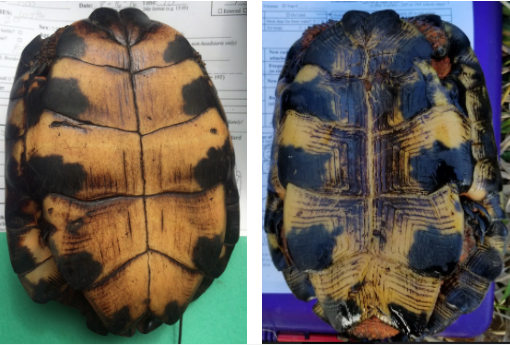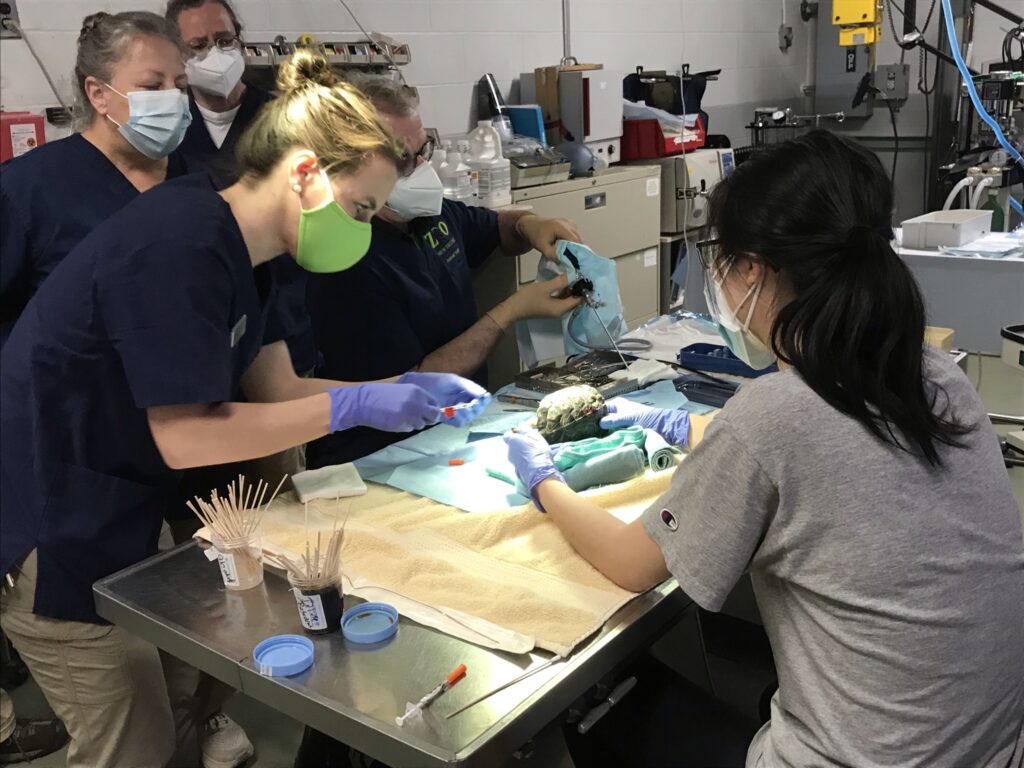Part 1: Telling them Apart
This is the first of a two-part series on sex determination in turtles – a fascinating and varied process with big implications for protecting rare species. Dr. Bryan Windmiller breaks it all down for us:
When we bring hatchling turtles to a class or kids, who are ready to raise them for a school year before returning them to the wild, one of the first questions we often are asked is: are these turtles girls or boys? The truth is, in most cases, we have no idea about the sex of turtles that we deliver to our headstarting schools.
As you may know, individuals of most turtle species can live for decades, some for well over a century. As part of that leisurely life history, turtles usually take quite a few years to become adults; that is, to reach sexual maturity. Blanding’s turtle females don’t begin to lay eggs until they are 14 – 20 years of age; other turtles can take nearly as long. Although identifying the sex of an adult turtle is usually fairly straightforward, at least for turtle biologists, it can be flat out impossible to correctly sex a young juvenile turtle just by looking at it. Yet that does not mean that it cannot be done.
In learning to tell the girls from the boys among turtles, let’s start with the relatively easy part: identifying the sex of adult turtles. Even this is not so straightforward. Like other reptiles, turtles have no external genitalia. The opening in their tails, through which they excrete liquids and solids, lay eggs, or evert their phallus, is called a cloaca (“sewer” in Latin – clearly not named that by a reptile) and looks similar in both sexes. However, in all turtles (at least all the species that we know of), the tails of adult males and females are shaped differently. Since males keep their phalluses tucked in at the base of their tails, when not mating, the base of a male turtle’s tail (the part below the cloaca) is longer and wider than in females. The relatively long tail base also facilitates mating. In New England turtle species, if you gently straighten the tail of an adult male turtle, the cloaca will usually extend beyond, often well beyond, the edge of the carapace; in females the cloaca often does not quite reach the edge of the carapace. (This is a bit trickier to see in common snapping turtles, who are also notably ill-tempered when biologists tug on their tails too much).

In many species, males also have a somewhat concave (scooped in) shape to their plastrons (bottom shell), whereas female plastrons are typically flat or slightly domed (convex).

Zoo New England is working to help restore populations of rare and threatened turtles, and we are raising young juveniles to release back into the wild to help boost their chances of surviving to adulthood. To achieve this, it is helpful to know that we are releasing a good mix of males and females at any one site. This is especially important when working with many turtle species, for reasons that we will discuss in our next blog post. So, if it’s important to know, and you are not patient enough to wait a dozen or so years before the differences in tail and shell shape are apparent, how can you tell juvenile female turtles from juvenile male turtles?
Most individual turtles hatch with clearly defined male or female sexual organs. They are, of course, “under the hood,” that is, within the body cavity and safely inside the shell. Fortunately, veterinary technology offers a way to find out without causing permanent injury or harm to the turtles: the laparoscopic examination.
In a laparoscopy, veterinarians insert a thin metal tube (the laparoscope) into the body cavity of an anesthetized patient, via a small skin incision. The end of the tube has a high-resolution camera lens and a bright fiber-optic light. The image is then viewed on a computer monitor, allowing the veterinarian to carefully steer the laparoscope toward the intended target. After the exam is complete, the veterinarian removes the “scope” and seals the wound, usually with the aid of surgical glue.
When our Field Conservation team first began headstarting Blanding’s turtles in 2007, Dr. Eric Baitchman, of Zoo New England, and his colleague, Dr. Charlie Innis, of the New England Aquarium, told us of recent breakthroughs in the use of laparoscopic techniques to determine the sex of young turtles. Drs. Baitchman and Innis, and their teams of technicians, began “scoping” many of our headstarted turtles in 2009. Since that time, the animal health teams at the zoo and aquarium have successfully and safely scoped more than 500 young Blanding’s and wood turtles, helping our field conservationists understand, among other things, the influence of sex on the movements, growth, and survival rates of young turtles.

Although laparoscopic sex examination, as done by our experienced veterinary teams, has proven safe and effective, it requires the turtles to be anesthetized and off their regular food and routines for a few days. We have, therefore, also put a fair bit of effort into researching ways to tell the sex of young turtles without the need for surgery. We’ll talk about some of those techniques in next week’s blog. Until then, happy spring!
